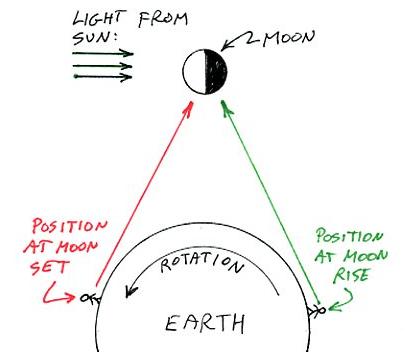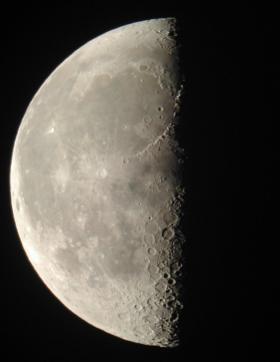
I was recently asked why the moon looks the same as it crosses the sky from east to west (looking south, moving left to right). With a third-quarter moon, shouldn't we see more of the dark portion when it's to our left, and more of the light portion when it's to our right? We know that the moon isn't really moving across the sky. Rather, the earth is rotating under it. I think what we imagine is something like what's shown below, with the sun, not in the picture, off to the left (way off to the left):  The long straight green and red arrows show the line of sight to the moon at moonrise and moonset, respectively. With that geometry, an observer should see less of the moon illuminated when it first rises, and more of the moon illuminated when it sets, like this:  But of course, that's not what is observed. In fact, the moon looks exactly the same as it moves from one side of the sky to the other. If it's a third-quarter moon, it's exactly half illuminated all the way across. Why is this?
What I did was to look up on the Internet the diameter of the earth, the diameter of the moon, and the distance from the Earth to the Moon. I then divided these numbers by 20 billion to convert to millimeters, enabling me to draw a diagram of the actual situation to scale. That's the diagram you see to the right. Note 2 That's the moon at the top, and the earth at the bottom, drawn to scale. I added the green and red sightlines showing the view of the moon at moonrise and moonset, as in the previous diagram. In this diagram, I didn't continue the lines all the way to the moon, because they started to get muddled together. I also didn't draw the little stick figures, which would have been difficult given the very small size of the circle representing the earth. When you see the actual picture with all of the dimensions properly scaled, I think it becomes clear why the appearance of the moon doesn't change as it progresses across the sky. The reason is that it's a very large object which is very far away, so that the angle at which we see it at moonrise and the angle at which we see it at moonset are barely different. Why is this so hard to picture without the diagram? I think it's because our brains are used to seeing things at distances that are more on a human scale. Most of the things we see in our day-to-day life are probably within 100 meters of us. We can look out over landscapes for quite a few kilometers, and we might see mountains that are dozens of kilometers away. But our brains are not used to seeing things like the moon and visualizing their actual distance. The distance of the moon is about 30 Earth diameters. That's something that's hard to wrap one's mind around. It seems so close. This isn't the first time I visualized the geometry of the earth and the moon. There may be some readers of my blog who recall an entry of over two years ago, called Dan and the moon. In that entry, I recalled my father teaching me about the rising of a full moon on the night of a lunar eclipse. More recently, I showed an impossible image involving the moon in my blog entry What's wrong with this picture?. If you click on those links, those blog entries will open in a separate window (or tab, depending on your browser). You can close that window or tab to return here. When Margie read this blog entry (I always have her review them before I publish them), she wondered aloud why there isn't a lunar eclipse once a month, one for every full moon? That's a good question. Why doesn't the moon pass through the Earth's shadow for each turn around? The answer is that the plane in which the moon goes around the earth is not the same as the plane in which the earth goes around the sun. The moon roughly circles the Earth's equator, and the axis of the earth is tilted 23.5 degrees from the plane in which the earth and most of the other planets go around the sun (called the "plane of the ecliptic"). The moon can only cross through the shadow of the earth as it dips through the plane of the ecliptic on the far side (from the sun) of the earth, which happens once every lunar month. But there will only be a lunar eclipse when that event coincides with a full moon. You can see a good video, and read a somewhat more detailed explanation, on EarthSky.org, here. As I discussed in Dan and the moon, all the little details become clear when you have the big picture.
  Note 1: Why is it called a "third quarter moon" when it's clearly one half illuminated? It seems this should be called a "half-moon". But in fact it's called a "third-quarter moon" because it's three quarters of the way through the full cycle. The phases are "new moon" (no moon, really), "first quarter", "full moon", and "third-quarter". The moon is first lit from the right, then becomes full, then in the third quarter is lit from the left. In order to remember this, someone once described it as a "Hebrew moon". That is, it reads from right to left, in a sense. [return to text] Note 2: The sizes are: Diameter of the moon: 3,480 Km. (2,160 miles)
The earth to moon distance actually varies a bit, because the moon's orbit is not perfectly circular. But the value given is accurate enough for our purposes. [return to text]
 |

 I found it hard to explain this in words when the question was first asked of me. But the answer is very easy to see if you draw a diagram, so that's what I've done. Because the diagram is so tall and narrow, I've put it along the right side of this page.
I found it hard to explain this in words when the question was first asked of me. But the answer is very easy to see if you draw a diagram, so that's what I've done. Because the diagram is so tall and narrow, I've put it along the right side of this page.